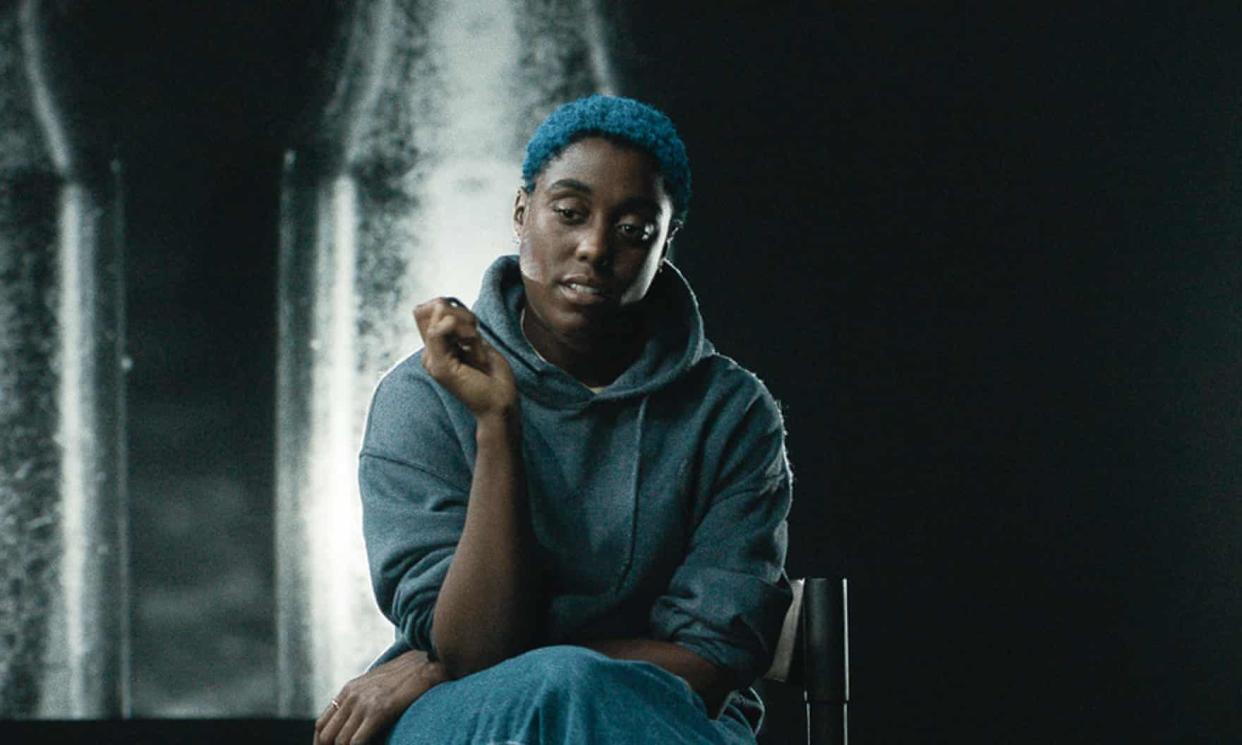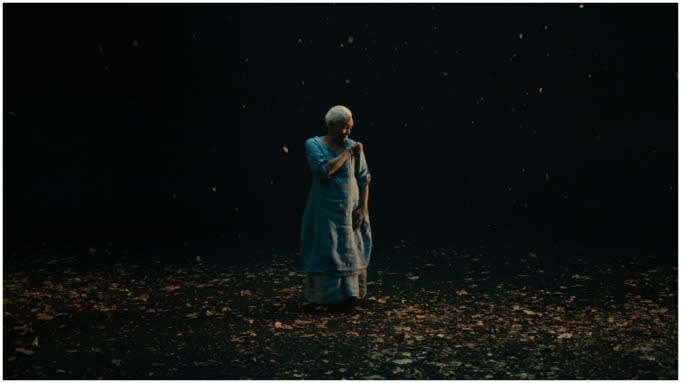‘Ear for Eye’ Review: This Rebellious and Revolutionary Masterpiece Demands to Be Seen


I have been consumed by this film.
The critically sharp, instantly poetic statement — “Ear for Eye” — conjures bursts of fiery rebuke, torrents of unassailable truths, waves of acute emotion that leap into your heart to root you back into a cathartic lineage. What happens to a dream deferred, not once, but several times? It doesn’t wither on the vine. It becomes sour, and rightfully distasteful.
More from IndieWire
For Black folks, it often feels like the dream has been so delayed that it now only exists in pained whispers and fractured promises. It happened during postbellum reconstruction, during the post-World War II boom, and again during the Civil Rights and Black Power movement. And now, over two years out from the summer of Black Lives Matter that was meant to alter everything — it has happened again.
The journey of playwright and director debbie tucker green’s “Ear for Eye” — now finally available in America via the Criterion Channel — is curiously apt. Based on tucker green’s same-titled stage play, the filmed version, visually retooled for the camera, played at the 2021 BFI London Film Festival and then premiered on the BBC. Despite the film’s urgent subject matter, which sees different sketches of Black folks debating what constitutes effective activism and how to combat state-sanctioned violence and its cumulative emotional and psychological toll — it has taken far greater time for this film to reach a wider audience than you’d expect.
In “Ear for Eye,” these aren’t your usual characters, so to speak, though people do powerfully testify within cinematographer Luciana Riso’s charged frames. Rather, the figures who do appear are akin to physical evocations of anger and regret, and deep resolve. They are nameless Brits and Americans occupying minimalist sets, couches here and a chair there, a cozy stoop to ruminate on, summoning specific places (Harlem, New York) or avant-garde dreamspaces.
The film is broken into three parts, each more startling than the last. It kicks off with actor Hayden McLean, reprising his role from the stage production, standing in the middle of a black void. The camera, positioned from a god-eye perch, spindles down around his form as other Black men dressed in black stand at his every side. They occupy a shallow pool of black water, shimmering with each spitted beat and bar soundtracks their movements. As he looks down at his hands, does he, in this opaque sea, feel fear or sorrow? “Ear for Eye” rarely diagrams such internalizations. Rather, tucker green asks for the audience to simply listen to the experiences, tribulations, and frustrations felt by this talented Black ensemble.
Tellingly, tucker green uses palms to punctuate the myriad of intense monologues and dialogues that populate her haunting drama. Historically, from the image of grandma’s hands to elaborate handshakes to clenched fists, the cultural symbolism of Black hands runs from comfort, to community, to empowerment. In “Ear for Eye,” however, tucker green locates the other mass proliferated signification of them: From grainy body-cam footage to cellphone videos witnessing police confronting Black people, hands up say to cops say, “Please, don’t shoot me” or “I can’t breathe.”
Back in 2021, many would have mistakenly referred to tucker green’s perceptive observation as timely. Now, as it was in 2018, when she originally staged the play at London’s Royal Court, it’s a reminder of the ever-present threat of anti-Black anxiety faced by Black people.

BFI
tucker green astutely translates the shared, multigenerational anguish of Black people by posing conversations that seem to transcend time. Playing McLean’s mom, Sharlene Whyte explains to him what white people see in Black hands: “Attitude, arrogance, insolence, defiance.” McLean attempts to negotiate with his mother. What if he turns his back or looks down at the floor? Isn’t the way she’s asking him to move through the world different from the confidence she instilled into him from birth? To remain unbowed yet alive for Black people is a dance on the edge of oblivion.
Before long an elderly Black woman (Carmen Munroe) ambles into the scene. At first, she speaks directly to Whyte, then turns to a gallery of young Black women listening to her sage, signifying words. “Before it was uploaded, downloaded, offloaded, done. Before they tried to dissect it, disrespect it, tried to disrupt it, counter it, infiltrate it, to destroy it,” she explains as the crushed leaves of fall gather at her feet. “When involved was physical, was difficult, was dangerous, is physical, is difficult, is danger,” she continues as snowflakes cascade.
The first half of her monologue, spoken in a mesmerizing staccato spells the new, online activism that blurs the line between brand making and community building. The latter statement reflexively bends the past and present tense, as though to say these things were such in their former form, but still exist as this, allowing the aims of each generation to cohabitate the primary problem: anti-Blackness.
tucker green doesn’t succumb to the sentimentalized sound of strings, cloying tears, or the infantilized coddling required to grant easy explanations to difficult questions. “Ear for Eye” moves with an unquestionably thought-provoking edge. Vignettes, formalistically, clash and careen, clash and collide with the intensity of the racism they’re contending with, threatening to shake the entire film to pieces. The pensively poetic language verbalizes the tension felt between old and young, white and Black. Who is at fault for the lack of contemporary activist gains: The previous generation for not winning enough battles or the newer fighters who aren’t getting deeper into the fray?
In one scene, an older man (Danny Sapani) attempts to comfort an upset younger man (Tosin Cole, reprising his stage role), even as he fights away his hugs. Preaching for war, the young man says, “This is a blood bath.” Despite his senior’s protestations, he continues: “How has this shit helped? Read a book. Then what? Shake your head at an article? See an image, turn over the TV?”
tucker green is unafraid of a closeup, understanding the realities and resentments that can tantalizingly play out over the face of an actor like Cole, who swings from deferential to furiously defiant as apocalyptic shades of rust orange and magenta are carved against his background. “Go listen to those who have lived more than you, years on you, talked quieter than you, and listen harder to them,” says the older man atop his stoop as black and white pictures of Angela Davis and the Black Panthers stream by. Similar confrontations play out in other scenes with other characters, those who have made protesting an aesthetic rather than a conviction. “Ear for Eye” reflects our world, and our strategies to combat its inequities with a quiet forcefulness.
tucker green grants her film a chance to unfold from interior debates to exterior targets: In part two, an impassioned American student (Lashana Lynch) fiercely argues with her patronizing white instructor (Demetri Goritsas) over the events of a recent school shooting perpetrated by a white terrorist agasinst Black students. Was the gunman driven by racism or environmental forces that render him a partial victim? You can guess who falls on which side. But the unrelenting spirit of the scene resides not in the facts of the case, but in the lens these facts are viewed through.
While the formalistic shift from vignettes to a straight-up two-hander is a major risk, it doesn’t blunt the momentum of tucker green’s visual and verbal voice. With each hit, the searing volleys reveal deeper fissures upon impact: Lynch, further establishing herself as among cinema’s most charismatic and emotive performers, in an artform desperately lacking actors with both, encapsulates the negotiations required for Black women to display intelligence without having to fight off accusation of being threatening. Through their debate, tucker green acknowledges the fragility of white victimhood, the apathy demonstrated toward real Black victims, and the charged debate around gun control.
The film’s final part is another drastic shift: An all-white cast, American and British, kids and the elderly, read off the historical lineage of anti-Black laws that were passed in antebellum and postbellum America. “There are to be no state funds to non-segregated schools” and “separate buildings for Black and white patients in hospitals for the insane” are just a couple of the sobering former legislative readings. The trick of this scene, however, isn’t how it tells of us past offenses, but how tucker green connects these antiquated rules to contemporary extralegal discrimination.
Outside of Ava DuVernay’s “13TH” and Garrett Bradley’s “Time,” few films have rendered and laid bare the grievous inequities literally baked into the fabric of our courts, documents, and institutions with the subtle grace and strong resolve shown by the director.
tucker green’s “Ear for Eye” is one of the most powerful pieces of filmmaking I’ve seen related to Black Lives Matter, the madness and psychosis of being Black in a white society, and the cycles Black activism works through, even as the obstacles toward change appear to remain the same no matter the century or decade. that swims so deep into the historical and public consciousness of race, you can’t help but be equally consumed by its unwavering depths.
Grade: A
“Ear for Eye” premiered at the 2021 London BFI Film Festival. While it was not distributed in the U.S., it is now available to stream on the Criterion Channel.
Best of IndieWire
New Movies: Release Calendar for April 14, Plus Where to Watch the Latest Films
From 'Nymphomaniac' to 'Little Ashes': Unsimulated Sex Scenes in 40 Films
Quentin Tarantino's Favorite Movies: 51 Films the Director Wants You to See
Sign up for Indiewire's Newsletter. For the latest news, follow us on Facebook, Twitter, and Instagram.

 Yahoo News
Yahoo News 
